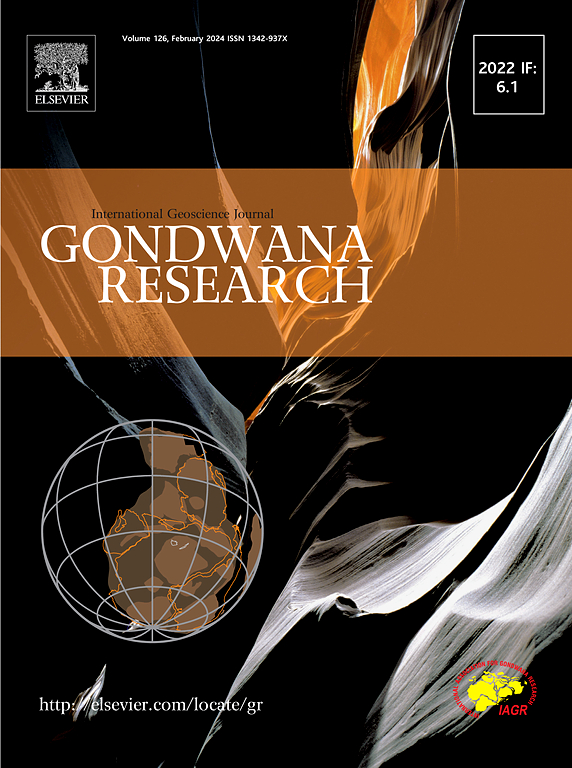牙形石多样性、生物地层学和环境动力学:揭示克什米尔Guryul峡谷的smith - spathian过渡
IF 7.2
1区 地球科学
Q1 GEOSCIENCES, MULTIDISCIPLINARY
引用次数: 0
摘要
在二叠纪-三叠纪界线大灭绝后约270万年,smith - Smithian- spathian界线(SSB)和smith - spathian界线发生了牙形石大灭绝。本研究对克什米尔斯利那加地区Guryul峡谷剖面的smith - spathian过渡进行了详细的研究,重点研究了牙形刺和δ13Ccarb值。该剖面具有前所未有的牙形刺分类丰富程度,共有17属53种,其中包括3个新正式确定的物种:Neospathodus aristatus n. sp.、Neospathodus guryulensis n. sp.和Borinella?此外,布氏博氏菌和米勒氏镰刀菌被细分为多种形态,促进了精细的生物年代学方案。早三叠世的高分辨率δ13Ccarb记录捕获了全球碳同位素漂移。δ13Ccarb与牙形石生物地层的整合增强了Smithian-Spathian过渡的全球相关性。史密斯晚期牙形石灭绝与全球观测到的正δ13Ccarb偏移一致,达到了+ 12‰的异常值,可能是成岩成因。本研究提出了一种新的基于单一关联法(UAM)的牙形石生物年代学框架。该框架将SSB置于灭绝高潮和再多样化开始之间,依赖于克什米尔Guryul峡谷丰富的牙形石收集,以及对冈瓦纳北部边缘其他19个断面牙形石数据的全面重新评估。得到的16个单一结合带(uaz)与岩性、化学地层(δ13Ccarb)和氨类标记物进行了交叉比对,为定义SSB建立了前所未有的坚实基础。拟议的边界在UAZ8内,但允许未来的改进。本文章由计算机程序翻译,如有差异,请以英文原文为准。

Conodont diversity, biostratigraphy, and environmental dynamics: Unravelling the Smithian-Spathian transition at Guryul Ravine, Kashmir
The late Smithian and Smithian-Spathian boundary (SSB) witnessed significant conodont extinction approximately 2.7 million years after the major Permian-Triassic boundary extinction. This study offers a detailed examination of the Smithian-Spathian transition at the Guryul Ravine section in the Srinagar district, Kashmir, focusing on conodonts and δ13Ccarb values. The section features an unprecedented conodont taxonomic richness, with 53 species from 17 genera, including three newly formalized species: Neospathodus aristatus n. sp., Neospathodus guryulensis n. sp. and Borinella? prima n. sp. Additionally, Borinella ex gr. buurensis and Scythogondolella ex gr. milleri are subdivided into multiple morphotypes, facilitating a refined biochronological scheme.
A high-resolution δ13Ccarb record spanning the Early Triassic captures global carbon isotope excursions. The integration of δ13Ccarb with conodont biostratigraphy enhances global correlation of the Smithian-Spathian transition. The late Smithian conodont extinction aligns with a globally observed positive δ13Ccarb excursion, reaching an exceptional value of + 12 ‰, likely of diagenetic origin.
This study proposes a new conodont biochronological framework based on the Unitary Association Method (UAM). Placing the SSB between the extinction climax and re-diversification onset, the framework relies on a rich conodont collection from Guryul Ravine, Kashmir, and a comprehensive reassessment of conodont data from 19 other sections along the northern Gondwana margin. The resulting 16 Unitary Association Zones (UAZs) are cross-referenced with lithological, chemostratigraphical (δ13Ccarb), and ammonoid markers, establishing an unprecedentedly robust basis for defining the SSB. The proposed boundary is within UAZ8 but allows for future refinements.
求助全文
通过发布文献求助,成功后即可免费获取论文全文。
去求助
来源期刊

Gondwana Research
地学-地球科学综合
CiteScore
12.90
自引率
6.60%
发文量
298
审稿时长
65 days
期刊介绍:
Gondwana Research (GR) is an International Journal aimed to promote high quality research publications on all topics related to solid Earth, particularly with reference to the origin and evolution of continents, continental assemblies and their resources. GR is an "all earth science" journal with no restrictions on geological time, terrane or theme and covers a wide spectrum of topics in geosciences such as geology, geomorphology, palaeontology, structure, petrology, geochemistry, stable isotopes, geochronology, economic geology, exploration geology, engineering geology, geophysics, and environmental geology among other themes, and provides an appropriate forum to integrate studies from different disciplines and different terrains. In addition to regular articles and thematic issues, the journal invites high profile state-of-the-art reviews on thrust area topics for its column, ''GR FOCUS''. Focus articles include short biographies and photographs of the authors. Short articles (within ten printed pages) for rapid publication reporting important discoveries or innovative models of global interest will be considered under the category ''GR LETTERS''.
 求助内容:
求助内容: 应助结果提醒方式:
应助结果提醒方式:


